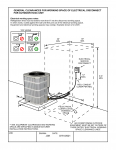Jgkopp
Member
- Location
- San Clemente
Being a former HVAC contractor, I see a need to inform the HVAC community of required electrical clearances. This drawing I did helps to illustrate and inform the HVAC contractor and I plan to post this information on a couple HVAC forums in the interest of educating them as they are selecting a suitable location for the outdoor unit. Looking for feedback here if this document Looks correct enough to publish.
The only questionable item in my mind is if there are other items routed through the working space is this allowed. Being the refrigeration lines are related to this installation I figured it was acceptable to have lines routed within a 6" space along the wall. On your forum, I am not sure if I selected the correct section for this post?
Thanks for your anticipated feedback.
John
The only questionable item in my mind is if there are other items routed through the working space is this allowed. Being the refrigeration lines are related to this installation I figured it was acceptable to have lines routed within a 6" space along the wall. On your forum, I am not sure if I selected the correct section for this post?
Thanks for your anticipated feedback.
John


